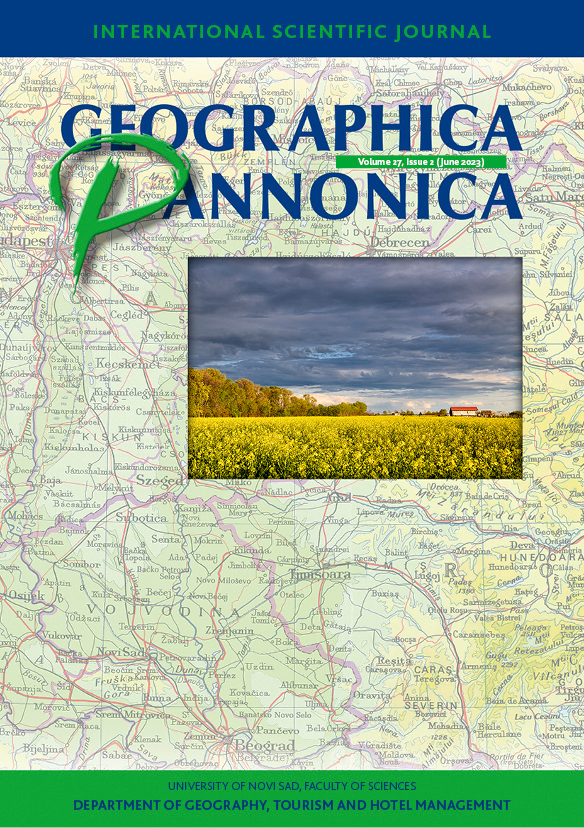‘Gay Space is wherever I am’: The Outlines of Pink Consumption Spaces in Croatia
Abstract
Based on the dialectical relationship between queerness and homonormativity, the aim of this paper was to outline the spatial framework of pink consumption in Croatia. Given that the LGBT community is a specific and sensitive social group, qualitative research methods were used. After calculating the gay index and establishing that the city of Zagreb provides the most favourable spatial context for studying pink consumption, we used the interview method to collect qualitative data. The sample was collected using the snowball technique (N = 14). The research established there are only few pink consumption places in Zagreb, that they do not even appear in all consumption systems, and that without exception they are located in the central part of the city. Although it cannot be claimed that these are completely homonormative places, indications of social exclusivity and sexual conservativism were detected. Therefore, it has been shown that even fundamentally inclusive places can produce normativity, which deprives them of the potential to achieve equality and emancipation of the Zagreb LGBT community.
References
Baudinette, T. (2017). The spatialisation of desire in Japanese gay district through signage. An International Journal for Critical Geographies, 16 (3), 500-527.
Bell, D., & Binnie, J. (2004). Authenticating queer space: citizenship, urbanism and governance. Urban Studies, 41 (9), 1807–1820.
Bettani, S. (2014). Straight subjectivities in homonormative spaces: Moving towards a new, ‘dynamic’ heteronormativity? Gender, Place & Culture: A Journal of Feminist Geography, 22, 239–254, DOI: 10.1080/0966369X.2013.855713
Braun, K., Cleff, T., & Walter, N. (2015). Rich, lavish and trendy. Is lesbian consumers' fashion shopping behaviour similar to gay's? A comparative study of lesbian fashion consumption behaviour in Germany, Journal of Fashion Marketing and Management, 19 (4), 445-466, DOI: 10.1108/JFMM-10-2014-0073.
Brown, G. (2009). Thinking beyond homonormativity: Performative explorations of diverse gay economies. Environment and Planning, 41, 1496–1510.
Brown, K., & Bakshi, L. (2011): We are here to party? Lesbian, gay, bisexual and trans leisurescapes beyond commercial gay scenes, Leisure Studies 30 (2), 179-196.
Burmaz, B. (2014). Gej klubovi u Beogradu: unutrašnja periferizacija kvir prostora [Gay clubs in Belgrade: internal peripheralization of queer space]. In: Blagojević, J. and
Dimitrijević, O., eds. Među nama: neispričane priče gej i lezbijskih života. Beograd: Hartefakt Fond, 190-209.
Cattan, N., & Vanolo, A. (2014). Gay and lesbian emotional geographies of clubbing: reflections form Paris and Turin, Gender, Place & Culture: A Journal of Feminist Geography, 21, 1158-1175, DOI: 10.1080/0966369X.2013.810603.
Collins, A., & Drinkwater, S. (2017). Fifty shades of gay: Social and technological change, urban deconcentration and niche enterprise, Urban Studies, 54 (3), 765-785, DOI: 10.1177/0042098015623722.
Dimitrov, S. (2014). Gej i lezbijski klubovi u Beogradu: društveni prostori, identiteti, otpor [Gay and lesbian clubs in Belgrade: social spaces, identities, resistance]. In: Blagojević, J.and Dimitrijević, O., eds. Među nama: neispričane priče gej i lezbijskih života. Beograd: Hartefakt Fond, 210-226.
Državni zavod za statistiku (DZS) / Croatian Bureau of Statistics (CBS) (2011). Popis stanovništva, kućanstava i stanova 2011. godine / Census of population, households and dwellings in 2011. Available from: www.dzs.hr (Accessed 8 Sep 2022).
Duggan, L. (2004). The Twilight of Equality? Neoliberalism, Cultural Politics and the Attack on Democracy. Boston: Beacon Press.
Florida, R. (2002). The Economic Geography of Talent, Annals of the Association of American Geographers, 92 (4), 743-755, DOI: 10.1111/1467-8306.00314.
Franceour, R. and Noonan, R. (2003). The Continuum Complete International Encyclopedia of Sexuality, New York-London: Continuum.
Gieseking, J. J. (2016). Dyked New York: The Space between Geographical Imagination and Materialization of Lesbian-Queer Bars and Neighbourhoods. In: Brown, G. and Browne, K., eds. The Routledge Research Companion to Geographies of Sex and Sexualities. Oxford: Routledge, 1983-2008.
Gorman-Murray, A., & Nash, C. (2017). Transformations in LGBT consumer landscapes and leisure spaces in the neoliberal city, Urban studies, 54 (3), 786-805., DOI: 10.1177/0042098016674893.
Hemmings, C. (2002). Bisexual spaces: A geography of sexuality and gender, New York: Routledge.
Hermann, E. (2016). Kako se kalio zagrebački LGBT clubbing. Voxfeminae.net. Available from: https://voxfeminae.net/pravednost/kako-se-kalio-zagrebacki-lgbt-clubbing/ (Accessed 26 Jun 2022)
Hubbard, P. (2001). Sex Zones: Intimacy, Citizenship and Public Space, Sexualities, 4 (1), 51-71.
Hunt, G., Antin, T., Sanders, E., $ Sisneros, M. (2019). Queer Youth, Intoxication and Queer Drinking Spaces, Journal of Youth Studies, 22 (3), 380-400 DOI: 10.1080/13676261.2018.1508826.
Jackson Lears, T. J. (1985). The Concept of Cultural Hegemony: Problems and Possibilities, The American Historical Review, 90 (3), 567-593.
Kates, S. M., (2002). The Protean Quality of Subcultural Consumption: An Ethnographic Account of Gay Consumers, Journal of Consumer Research, 29 (3), 383-399, DOI: 10.1086/344427.
Kenttamaa-Squires, K. (2019). Rethinking the homonormative? Lesbian Hispanic Pride events and the uneven geographies of commoditized identities, Social & Cultural Geography, 20 (3), 367-386. DOI: 10.1080/14649365.2017.1362584.
Mak, K., & Jakovčić, M. (2021). Ružičasti prostori potrošnje: istraživački dosezi i perspektive / Pink consumption areas: research accomplishments and future perspectives, Hrvatski geografski glasnik, 83 (2), 59-77, DOI: 10.21861/HGG.2021.83.02.03
Mattson, G. (2015). Style and the value of gay nightlife: Homonormative placemaking in San Francisco, Urban Studies, 52 (16), 3144-3159.
Ministarstvo pravosuđa i uprave (MPU) / Ministry of Justice and Public Administration (MJPA) (2022): Registar životnog partnerstva / Register of Life Partnership. Available from: www.mpu.gov.hr (Accessed 8 Sep 2022).
Motschenbacher, H. (2020). Walking on Wilton Drive. A linguistic landscape analysis of a homonormative space, Language & Communication, 72, 25-43.
Prelogović, V. (2009). Primjena faktorske analize u istraživanju socio-prostorne strukture grada: primjer Zagreba [The application of factor analysis in the study of the socio-spatial structure of the city: the example of Zagreb], Hrvatski geografski glasnik, 71 (1), 67-85.
Romeo (2022). Your GPS-Position, Your Security. Available from: https://www.romeo.com/en/care/locations/ (Accessed 26 Jun 2022).
Schulman, S. (2012). The Gentrification of the Mind. Witness to a Lost Imagination, Berkeley: University of California Press.
Skočir, D., & Šakaja, L. (2017). Prostorni aspekti posjećenosti kafića u Zagrebu: dobne i rodne razlike [Spatial aspects of visiting cafes in Zagreb: age and gender differences], Acta Geographica Croatica, 43/44 (1), 37-58.

